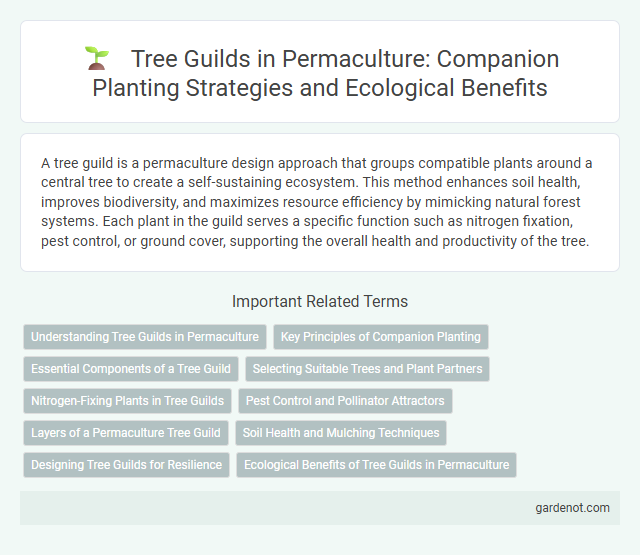A tree guild is a permaculture design approach that groups compatible plants around a central tree to create a self-sustaining ecosystem. This method enhances soil health, improves biodiversity, and maximizes resource efficiency by mimicking natural forest systems. Each plant in the guild serves a specific function such as nitrogen fixation, pest control, or ground cover, supporting the overall health and productivity of the tree.
Understanding Tree Guilds in Permaculture
Tree guilds in permaculture consist of mutually beneficial plants that support a central tree, enhancing nutrient cycling, pest control, and soil fertility. Key elements include nitrogen-fixing plants, dynamic accumulators, ground covers, and insect-repelling species arranged to optimize growth and resilience. This polyculture approach creates sustainable ecosystems that improve biodiversity and productivity in permaculture design.
Key Principles of Companion Planting
Tree guilds in permaculture utilize key principles of companion planting, including biodiversity, nutrient cycling, and pest control, to create synergistic plant communities. Nitrogen-fixing species like clover enrich soil fertility while dynamic accumulators such as comfrey bring up essential minerals, enhancing tree health and productivity. Multi-layered planting structures maximize sunlight capture and habitat diversity, promoting resilience and ecosystem stability within the guild.
Essential Components of a Tree Guild
A tree guild integrates essential components such as nitrogen-fixing plants, dynamic accumulators, and pollinator attractors that support the primary tree species by enhancing soil fertility, pest control, and biodiversity. Deep-rooted plants improve soil structure and facilitate water retention, while ground covers suppress weeds and reduce erosion. This synergistic plant community creates a resilient, self-sustaining ecosystem promoting long-term productivity in permaculture design.
Selecting Suitable Trees and Plant Partners
Selecting suitable trees and plant partners in a tree guild involves choosing species that mutually benefit each other through nutrient cycling, pest control, and microclimate enhancement. Nitrogen-fixing trees like black locust or alder improve soil fertility, while dynamic accumulators such as comfrey draw up essential minerals from deep soil layers. Companion plants, including herbs like mint and flowers like yarrow, attract beneficial insects and repel pests, fostering a resilient and productive ecosystem.
Nitrogen-Fixing Plants in Tree Guilds
Nitrogen-fixing plants in tree guilds play a vital role in enhancing soil fertility by converting atmospheric nitrogen into bioavailable forms, supporting the growth of surrounding plants. Common nitrogen-fixing species include Albizia, Acacia, and Elaeagnus, which form symbiotic relationships with root-nodulating bacteria to enrich the ecosystem naturally. Integrating these plants within permaculture tree guilds improves nutrient cycling, reduces the need for synthetic fertilizers, and promotes sustainable agricultural practices.
Pest Control and Pollinator Attractors
Tree guilds utilize pest control plants such as marigolds, garlic, and chives to naturally reduce harmful insect populations and protect fruit trees without chemicals. Pollinator attractors like lavender, borage, and sunflowers enhance pollination rates by drawing bees, butterflies, and other beneficial insects crucial for fruit set and biodiversity. Integrating these functional plants within tree guilds fosters a balanced ecosystem, improving yields and reducing the need for synthetic inputs.
Layers of a Permaculture Tree Guild
A permaculture tree guild consists of multiple plant layers that mimic natural ecosystems to enhance biodiversity and resource efficiency. These layers include canopy trees, understory trees, shrubs, herbaceous plants, ground covers, root crops, and vines, each serving specific ecological functions such as nitrogen fixation, pest control, and nutrient cycling. Integrating diverse species within these layers creates a resilient and self-sustaining system, optimizing sunlight capture and soil health.
Soil Health and Mulching Techniques
Tree guilds enhance soil health by integrating diverse plant species that improve nutrient cycling, promote beneficial microbial activity, and increase organic matter content. Mulching techniques such as applying wood chips, leaf litter, or straw around trees conserve moisture, suppress weeds, and gradually decompose to enrich the soil with essential nutrients. These practices foster a resilient ecosystem, improving tree growth and long-term soil fertility in permaculture systems.
Designing Tree Guilds for Resilience
Designing tree guilds for resilience involves integrating diverse plant species that support soil health, enhance nutrient cycling, and provide pest control through natural predator habitats. Incorporating nitrogen-fixing plants, dynamic accumulators, and pollinator-attracting flowers strengthens ecosystem stability and improves overall yield in permaculture landscapes. This strategic layering of functional plants creates mutually beneficial relationships, increasing resistance to environmental stress and promoting long-term sustainability.
Ecological Benefits of Tree Guilds in Permaculture
Tree guilds in permaculture create synergistic relationships among diverse plant species, enhancing soil fertility, improving water retention, and increasing biodiversity. These ecological benefits promote pest control through natural predators and reduce the need for chemical inputs, fostering a resilient and self-sustaining ecosystem. By mimicking natural forest structures, tree guilds contribute to carbon sequestration and support pollinator habitats, strengthening overall ecosystem health.
Tree guild Infographic

 gardenot.com
gardenot.com